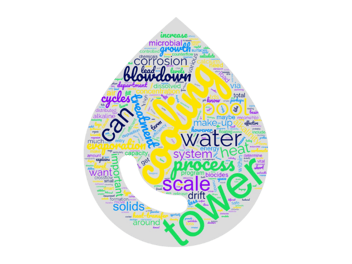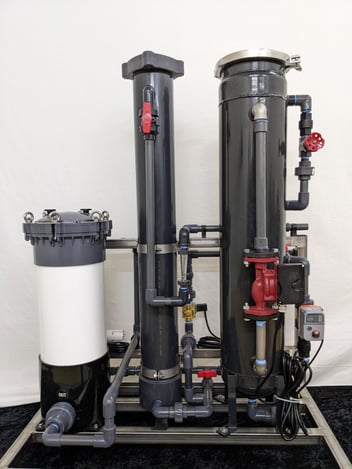Cooling Tower Cycles of Concentration (COC): What You Need to Know
No matter the industry, metrics are the things by which you can quantifiably measure all aspects of your operation ... and for the cooling tower water treatment industry, cycles of concentration is one of the most important top-line numbers you can monitor.
With some basic measurements and calculations, the cycles of concentration figure can tell you a lot about how a cooling tower is operation, including the external conditions under which it is operating. (Elsewhere, we summarized some other key terms and metrics for the cooling tower water treatment industry.)
Basically, it's really important, like a baseball player's batting average or a quarterback's completion percentage.
But like all numbers, there's a story beneath the numbers that has to be understood before we even know what to think about cycles of concentration and what might be an appropriate number.
In this article, we'll briefly touch on:
- The basic definition of cycles of concentration in cooling towers
- How to calculate cycles of concentration
- Things to keep in mind when determining the right cycles of concentration level for your site
Cooling Tower Cycles of Concentration in Cooling Towers Definition
Cycles of concentration (often abbreviated as COC) describe the ratio of dissolved minerals and solids in a cooling tower’s circulating water compared to the make-up water. As water evaporates from a cooling tower, it leaves behind minerals such as calcium, magnesium, chlorides, and sulfates. These accumulate in the remaining water, increasing its concentration.
The cycles of concentration provide a simple way to measure and manage this buildup. For example, if the circulating water contains four times as many dissolved solids as the fresh make-up water, the system is operating at four cycles of concentration.
Maintaining proper cycles of concentration is critical. Too few cycles waste water and increase operating costs, while too many cycles cause scaling, corrosion, and fouling of equipment.
For example, some cooling towers, which might be located in parts of the world facing more acute water scarcity, might tend toward an elevated cycles of concentration figure in order to reduce water consumption. One study of a cooling tower servicing a power plant operation found that increasing cycles of concentration from 6.5 to 9 led to water savings of 1.1 × 106 m3 per year while accomplishing the same level of cooling.1
However, as a result, these types of sites might need more aggressive strategies to get ahead of corrosion, scale and microbial growth, which greatly impact the heat transfer capabilities of the cooling tower.
Many cooling towers operate at much lower cycles of concentration than the aforementioned example. According to the U.S. Department of Energy, many cooling towers operate from 2-4 cycles of concentration. Increasing cycles of concentration from three to six reduces makeup water consumption by 20% and blowdown by 50%, the DOE notes on its website.
'How Do I Calculate Cycles of Concentration for my cooling tower?'
The most common way to calculate cycles of concentration is by comparing key water chemistry measurements between make-up and blowdown water.
There are a few different ways you can do it:
Conductivity ratio
Cycles = (Circulating Water Conductivity ÷ Make-up Water Conductivity)
This method is fast and cost-effective since conductivity meters are widely available.
Chloride ratio
Cycles = (Chloride in Circulating Water ÷ Chloride in Make-up Water)
Chloride ratio is another method by which to calculate your COC.
Silica or hardness ratio
In some regions, silica or calcium hardness is used instead of chloride, depending on local water chemistry.
No matter which method is chosen, consistency is key. Many facilities rely on automated controllers that monitor conductivity in real time and adjust blowdown accordingly.
How to Determine the Ideal Cycles of Concentration for Your Site
We always say every cooling tower is different. There are a number of variables that contribute to determining the what you should target for your site's cycles of concentration regimen. 
Just like you might change how you deliver personal advice to person A versus person B, advice related to cycles of concentration comes with one main caveat: you need to do what produces the best outcomes for your site based on its unique conditions.
With that in mind, it's important to do the necessary homework for your operation. Making the most accurate determination can mean cost savings and better performance.
The “ideal” cycles of concentration vary based on water quality, tower design, and treatment programs. Setting the right balance is essential for maximizing efficiency while protecting equipment.
Five Factors to Keep in Mind When Determining Cycles of Concentration
Water Chemistry Limits
Every cooling tower system has maximum allowable levels of calcium, silica, alkalinity, and chlorides before scaling, fouling, or corrosion becomes a risk. Water treatment vendors typically run detailed analyses and set upper limits tailored to the site.
Blowdown and Water Use
Higher cycles of concentration reduce blowdown frequency, which saves water and decreases sewer discharge costs. However, pushing cycles too high without proper control can lead to scaling that reduces heat transfer efficiency.
Treatment Program
The chemicals used for scale and corrosion control, such as phosphonates or polymer dispersants, directly influence the achievable cycles. A robust water treatment program can safely extend the cycles, depending on water quality.
Environmental and Regulatory Requirements
Local discharge permits may restrict certain parameters, such as chlorides or total dissolved solids (TDS), limiting how high the cycles can be set. Whatever the case may be, you need to be aware of those requirements and have them in mind when assessing your treatment regimen (i.e., deciding if you want to increase or decrease cycles of concentration).
System Monitoring and Automation
Regular testing and automated conductivity controllers make it easier to safely operate at higher cycles without risking equipment damage. Data is the the common thread in all of this: you can't assess what you don't measure. Having this historical data on hand helps you make more informed decisions about your cooling tower water treatment plan.
Cycles of Concentration in cooling towers: It's all about balance
Optimizing cycles of concentration is about balance. Operating too low wastes water and money, while operating too high risks scale, corrosion, and equipment downtime.
By carefully analyzing make-up water quality, monitoring key parameters, and working with a qualified water treatment specialist, facilities can determine the ideal cycles of concentration for their cooling tower.
When optimized, proper cycles of concentration lead to lower water consumption, reduced chemical use, improved energy efficiency, and longer equipment life. All of that contributes to more sustainable and more cost-effective cooling tower operation.
Just like a seesaw, it can take some time to calibrate its operation in a way that makes sense. A cooling tower is no different in that way: it's all about balance and striving to find it.
The Smart Release Technology team has decades of experience in helping cooling tower operators achieve simple, safer, reliable water treatment processes in their cooling towers. Reach out to learn more about how Smart Release Technology equipment and solid chemicals can help you achieve the perfect cycles of concentration balance for your site.
References
- Kh. Rahmani, Reducing water consumption by increasing the cycles of concentration and Considerations of corrosion and scaling in a cooling system,
Applied Thermal Engineering, Volume 114, 2017, Pages 849-856, ISSN 1359-4311, https://doi.org/10.1016/j.applthermaleng.2016.12.075. (https://www.sciencedirect.com/science/article/pii/S1359431116341849)




